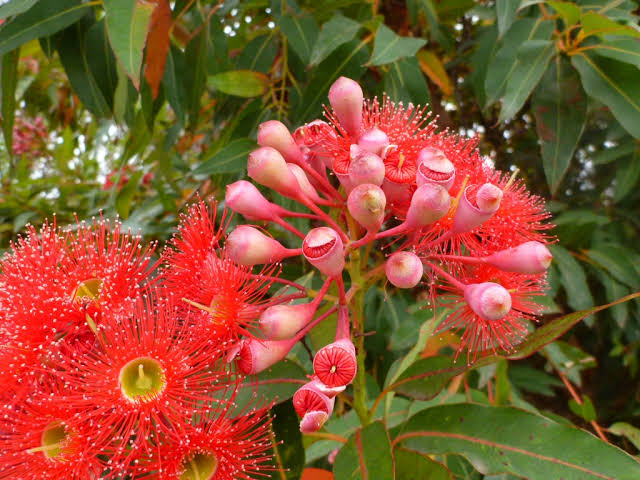Introduction
Imagine a tree bursting with fiery red, orange, or pink flowers, attracting bees, birds, and butterflies. That’s Corymbia ficifolia, also known as the Red Flowering Gum. This breathtaking tree is one of the most beautiful Australian native plants, widely grown for its vibrant blossoms and resilience.
Whether you’re a gardening enthusiast or just love stunning landscapes, this blog will guide you through everything you need to know about . From its origins and care tips to why it’s a perfect addition to your garden, we’ve got it all covered!
What is Corymbia Ficifolia?
Corymbia ficifolia is a species of flowering gum tree native to southwestern Australia. It was previously classified under the Eucalyptus genus but later moved to Corymbia. Known for its spectacular blooms and compact size, it’s a favorite among gardeners looking to add color and life to their landscapes.
Quick Facts About Corymbia Ficifolia
- Scientific Name:
- Common Names: Red Flowering Gum, Albany Red Gum
- Family: Myrtaceae
- Native To: Western Australia
- Height: 4-10 meters (depending on variety)
- Flowers: Red, pink, orange, or salmon
- Foliage: Dark green, glossy leaves
- Lifespan: Over 50 years
- Preferred Climate: Warm, dry regions
Why You Should Grow Corymbia Ficifolia
1. Breathtaking Flowers
One of the biggest reasons to plant is its stunning flowers. The tree produces clusters of bright red, pink, or orange blooms during summer, creating a spectacular show.
2. Attracts Wildlife
This tree is a magnet for bees, butterflies, and birds. The nectar-rich flowers provide food for pollinators, making it an excellent choice for eco-friendly gardens.
3. Drought-Tolerant & Low Maintenance
is highly drought-resistant once established. It thrives in poor soils and requires little maintenance, making it perfect for busy gardeners.
4. Compact & Suitable for Small Gardens
Unlike some large eucalyptus trees, Corymbia ficifolia stays relatively compact (around 4-10 meters tall). This makes it a great choice for small gardens or urban spaces.
5. Year-Round Beauty
Even when not in bloom, the tree remains attractive with its dark green leaves and sculptural branches. It provides shade and enhances the aesthetic of any landscape.
How to Grow and Care for Corymbia Ficifolia
1. Choosing the Right Location
- Plant in a sunny spot with at least 6 hours of direct sunlight daily.
- Prefers well-drained soil (avoid waterlogged areas).
- Can be grown in pots if space is limited.
2. Soil & Watering Needs
- Adapts to various soil types, but prefers sandy or loamy soil.
- Water regularly during the first year, then reduce watering as the tree matures.
3. Fertilizing for Best Growth
- Use a low-phosphorus native plant fertilizer in spring.
- Mulch around the base to retain moisture and prevent weeds.
4. Pruning & Maintenance
- Prune young trees to encourage strong branch structure.
- Remove dead or weak branches as needed.
- Generally, this tree requires minimal pruning once established.
5. Pest & Disease Resistance
- Corymbia ficifolia is resistant to most pests.
- Occasionally, it may attract scale insects or borers—treat with insecticidal soap if necessary.
Best Varieties of Corymbia Ficifolia
1. ‘Wildfire’
- Deep red flowers
- Compact growth, ideal for small gardens
2. ‘Fairy Floss’
- Soft pink blossoms
- Excellent for urban landscapes
3. ‘Summer Red’
- Bright scarlet flowers
- Medium-sized tree, great for driveways
4. ‘Baby Scarlet’
- Dwarf variety (only 3-4m tall)
- Perfect for pots and courtyards
Common Problems & Solutions
Conclusion
corymbia ficifolia is an absolute gem in any garden. With its dazzling flowers, ability to attract wildlife, and low-maintenance nature, it’s an excellent choice for gardeners of all skill levels. Whether you want a statement tree in your backyard or a compact flowering beauty in a pot, this tree won’t disappoint!
If you’re looking for a hardy, beautiful, and wildlife-friendly tree, Corymbia ficifolia is the perfect addition to your outdoor space.
FAQs
1. Can Corymbia ficifolia grow in cold climates?
It prefers warm, dry regions but can tolerate mild frost. In colder areas, consider planting in a sheltered spot or a large pot that can be moved during winter.
2. How fast does Corymbia ficifolia grow?
It grows moderately fast, reaching around 2-3 meters in the first few years and eventually up to 10 meters at full maturity.
3. Does Corymbia ficifolia have invasive roots?
No, it has a non-invasive root system, making it safe to plant near driveways, patios, and fences.
4. Can I grow Corymbia ficifolia in a pot?
Yes! Dwarf varieties like ‘Baby Scarlet’ are perfect for pots. Just make sure to use well-draining soil and a large container.
5. When is the best time to plant Corymbia ficifolia?
Spring and early autumn are the best times to plant, as this allows the tree to establish before extreme temperatures.
6. Does Corymbia ficifolia attract bees?
Absolutely! The nectar-rich flowers are highly attractive to bees, butterflies, and native birds.




